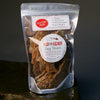Product Description
Wild Caught Coho Portions
Our Wild Caught Coho Salmon portions are packaged individually with 6 oz servings. They are each flash frozen and vacuumed packaged. Coho salmon has a mild flavor and firm texture. Coho is a great mild salmon choice for seafood lovers who aren’t as keen on the more intense, richer flavors of some salmon. Portions are cut from the whole fillet; each shipment will contain a variety of collar, center, and tail pieces.
Please note: Due to the small-batch nature of our Coho salmon processing facility, portions come skin-on and bone-in.
For recipe ideas and more cooking instructions - visit our Wild for Salmon blog here.
Troll caught, pressure bled, then hand cut and processed, these fish are probably the highest quality salmon on the market. Troll fishing — not to be confused with trawling — involves towing individual anchored lines from a slow-moving boat. Trolling is sustainable because the unwanted catch is minimal and can be quickly released.
Sustainably Harvested & Wild Caught in Bristol Bay, AK & Processed in the USA
*Cooked, 3 oz./ 85 g | Source: USDA Standard Reference Release 28 | Rounded per FDA guidelines
Alaskan Coho Salmon Portions (Bone-In)
Alaskan Coho Salmon Portions (Bone-In)
Couldn't load pickup availability
Product Description
Wild Caught Coho Portions
Our Wild Caught Coho Salmon portions are packaged individually with 6 oz servings. They are each flash frozen and vacuumed packaged. Coho salmon has a mild flavor and firm texture. Coho is a great mild salmon choice for seafood lovers who aren’t as keen on the more intense, richer flavors of some salmon. Portions are cut from the whole fillet; each shipment will contain a variety of collar, center, and tail pieces.
Please note: Due to the small-batch nature of our Coho salmon processing facility, portions come skin-on and bone-in.
For recipe ideas and more cooking instructions - visit our Wild for Salmon blog here.
Troll caught, pressure bled, then hand cut and processed, these fish are probably the highest quality salmon on the market. Troll fishing — not to be confused with trawling — involves towing individual anchored lines from a slow-moving boat. Trolling is sustainable because the unwanted catch is minimal and can be quickly released.
Sustainably Harvested & Wild Caught in Bristol Bay, AK & Processed in the USA
*Cooked, 3 oz./ 85 g | Source: USDA Standard Reference Release 28 | Rounded per FDA guidelines
 sssss
sssss sssss
sssss
Frequently Asked Questions
How will I receive my product?
Items are shipped in an insulated box with dry ice to keep items frozen until they reach your home. All orders are shipped via FedEx unless another carrier is requested by the customer. You will be emailed the tracking information as soon as the order ships. Please allow until 8PM for updated information from FedEx.
How is the fish packaged?
All products are Individually vacuum-sealed in BPA-free plastic.
What does “Sustainably Harvested” mean?
For sockeye salmon, the Alaska State Department of Fish and Game monitors all commercial, sport, and residential salmon fishing. This means a set number of permits are sold each season based on predictions of the number of salmon expected to return to spawn. As the salmon move towards the bay, researchers actively monitor their movement and count the number of salmon in each school. They then use this data to determine when the fishermen are allowed to fish, if the volume of salmon is too low they are not allowed to fish. Once the volume rises to a number which allows for enough fish to escape upstream to spawn, the fishermen are given a set amount of time that they are allowed to fish. This timed fishing allowance and escapement number is vital to the sustainability of salmon.
How should I store my seafood?
We guarantee the quality of our products to be maintained for one year from purchase when kept in proper conditions. All seafood should be kept in a freezer that maintains even temperature, do not store any seafood on the door or towards the front of the freezer, and do not stack other items on top of seafood. If your seafood loses its vacuum seal, plan to use those pieces first! They are still completely safe to eat but are more prone to freezer burn. Freezer burn is the process of water being pulled from the fish and turned into ice crystals.




 Wild Alaska Salmon
Wild Alaska Salmon Alaska Salmon Burgers
Alaska Salmon Burgers Smoked Salmon & Seafood
Smoked Salmon & Seafood Wild Alaska Whitefish
Wild Alaska Whitefish Wild Shellfish & Shrimp
Wild Shellfish & Shrimp Wild Albacore Tuna
Wild Albacore Tuna Canned Seafood
Canned Seafood Meal Box & Samplers
Meal Box & Samplers Pet Products
Pet Products Gifts
Gifts Specialty
Specialty Wholesale Ordering
Wholesale Ordering





